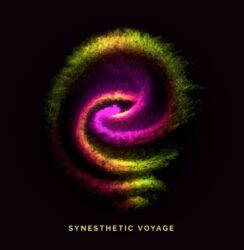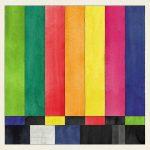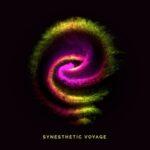CLARICE JENSEN – ESTHESIS 
On her third full album (not counting EP’s and single tracks), Clarice Jensen explores ‘the emotional and harmonic spectrum’ and its relation to the chromestesia phenomenon: ‘a condition whereby sound involuntarily evokes an experience of color, shape and movement’. Hence the track titles (Liking, Sadness, Anger, Disliking, Joy, Fear, Love) and the colorful artwork.
Which color belongs to which emotion is up to the listener to decide. At home, at least, because this project was originally intended as a concert experience, for which ‘Jensen imagined the audience being bathed in colored lights that corresponded to each drone, with those colors combined or oscillating during the songs in an effort to mimic or induce chromesthesia: a (gentle, not jarring) trip through the complete spectrum of color, (Western) pitch and emotion.’
But then the global pandemic hit and then the music became more focused on all kinds of principal emotions and their relation to enforced solitude and isolation.
Though originally a cello player, here Clarice Jensen here mainly uses synths and electronics. Some aid comes from Timo Andres on piano, and the voices of Laura Lutzke, Francesco Federico and Emma Broughton.
Esthesis (which means ‘rudimentary sensation’) covers a wide range of emotions, which naturally means that the tracks also cover a wide range of styles. Still, the album is remarkably coherent: the tracks fit together naturally like the colors of a rainbow.
After the ‘likable’ opening track called Liking, you may be surprised to recognize the theme of Purcell’s Dido’s Lament (‘When I Am Laid In Earth’) in the track Sadness following it. Other tracks, such as Fear, are far more abstract in nature. (‘Fear attempts to simply portray breathing and absence’). Only to be followed by the intimate closing track Love, a track in which you can drown yourself in the sound of the organs ’employing only a short progression that always returns to the same but becomes layered, out-of-sync and lost, but simplest at its end’.
VOID POINTER – SYNESTHETIC VOYAGE 
Void Pointer is the alias of Peter Spaargaren, a Dutch musician with a track record in Techno and Tech-House (also known as deFusion). But on Synesthetic Voyage he demonstrates his ambient (or perhaps ambient-techno) capabilities.
The first thing to note is that Void Pointer must not be confused with the óther Void Pointer from Ireland – the difference (on Bandcamp) is the hyphen after Void. Both may be electronic acts, but they are not comparable in any way.
Synthetic Voyage is a set of (six) dreamy soundscapes, all originating from a jam session and slightly tweaked afterward.
If you feel that this music would fit nicely as a videogame soundtrack you are right: some (most?) of this music is featured in Oakenfold – available on Steam, developed by Rutger van Dijk. The key feature of this game is the ‘TimeScrubber’ that you can use to reverse time if your strategy didn’t work.
In fact, that is a nice analogy to the music on Synthetic Voyage. It is definitely contemporary music, but it also has a nice comforting and somewhat nostalgic ’90s’ feel. So, if you feel the need, simply use Synthetic Voyage as your sonic TimeScrubber.





